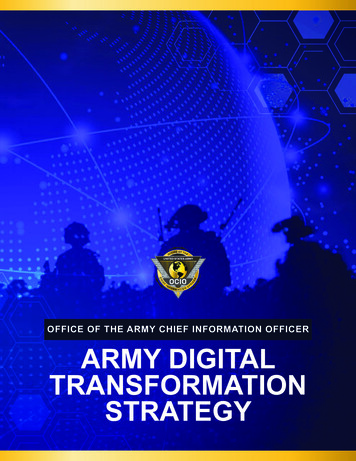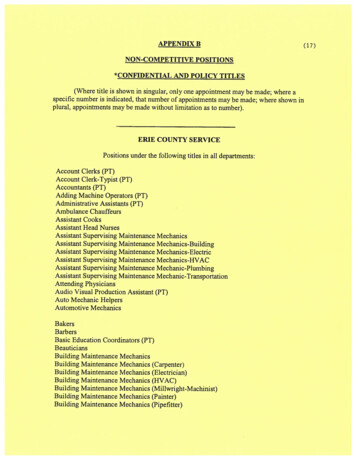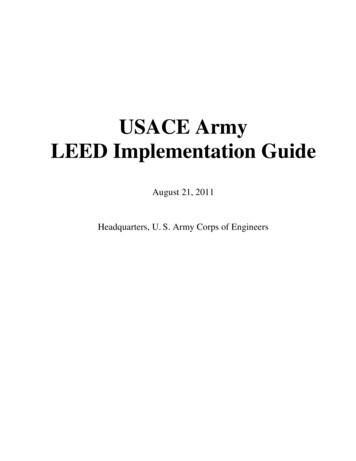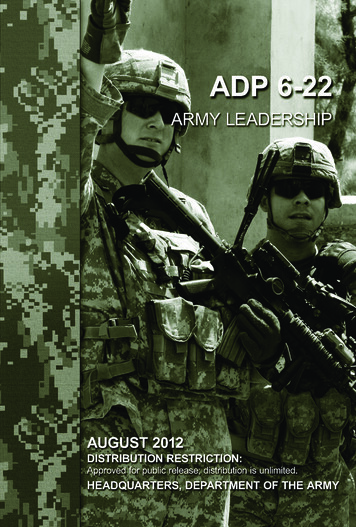
Transcription
OFFICE OF THE ARMY CHIEF INFORMATION OFFICERARMY DIGITALTRANSFORMATIONSTRATEGY
Headquarters,Department of the Army12 October 2021Army Digital Transformation StrategyDISTRIBUTION STATEMENT A:Approved for public release, distribution is unlimited
THE JOURNEY TO ARMY WAYPOINT 2028As the Army marches toward its goals of being a more ready, lethal, andmodern force by 2028, it faces unprecedented challenges in modernizingits platforms and weapons systems, but also its business processes andworkforce to dominate adversaries on and off the battlefield in multidomain operations (MDO).The Army Digital Transformation Strategy (ADTS), established bythe Office of the CIO, is the overarching framework that will set thevision, establish lines of effort (LOE), and implement strategic digitaltransformation initiatives prioritized and resourced as required toachieve this end state. Each LOE and initiative must be outcome drivento ensure that it is operationally effective in a resource constrainedfuture.The Army must and will make bold investments in transformativedigital technologies, build the workforce into one with the training andexperience to execute the full range of Army missions in increasinglycomplex technological environments, and put the right data in decisionmakers’ hands quicker than ever before.The Office of the CIO will lead these efforts for the Army in partnershipwith Headquarters, Department of Army (HQDA), Army Commands,Army Service Component Commands (ASCCs), Direct Report Units(DRUs), the DoD CIO and Joint Staff, and Allied Nation Partners asrequired.Christine E. WormuthSecretary of the ArmyARMY DIGITAL TRANSFORMATION STRATEGY 1
STRATEGIC INTENTThe adoption of leading edge technologies by theArmy’s and the United States’ near-peer adversaries,combined with the rapid pace of change in technology, iscreating new and complex challenges for how the Armyoperates and maintains overmatch across all domains– land, sea, air, space, and cyberspace. As the Armyresponds to the growing need for digital technologiesthrough Army modernization programs, the cybersecurityattack surface area is growing exponentially, and thedynamic threat environment requires the Army to makefundamental changes to address security in all phasesof the lifecycle to ensure the Army is poised for defensiveand offensive cyber operations. The Army must adapt adata-driven mindset and embrace digital transformationto successfully respond to the threat of great powercompetition and win decisively in a Large Scale CombatOperations through MDO.The Army Modernization Strategy identifies digitaltransformation as the means to modernize the Armyto achieve Waypoint 2028 and Aimpoint 2035. Digitaltransformation represents a shift in operations and culturethat fundamentally changes how an organization deliversvalue through the adoption of advanced technologiessuch as cloud, data and artificial intelligence (AI). Digitaltransformation is driven through innovation and newbusiness and operating models, powered by a digitalworkforce that is agile, adaptive, and tech-savvy. Digitaltransformation is an enabler for Army readiness andreform and serves as a catalyst to revitalize and establishthe Army’s digital workforce of the future. The Armymust keep pace with the rapid change in technology,adopt modern best practices, and avoid any delays frombureaucratic institutional processes. The Army must makebold investments in transformative digital technologies,reform its institutional processes, and build its workforceinto one with the training and experience to execute inincreasingly complex operational environments with thetechnological innovation that places the right data indecision makers’ hands quicker.The Army must accomplish digital transformation in afiscally constrained future. To accomplish this, reformefforts are needed to continually assess the Army’s digitalportfolio, explore opportunities for divestment of legacysystems, re-engineer business processes, adopt greaterautomation, and find savings through consolidation andbetter buying power. The cost avoidance harvested fromsuch reform efforts can be re-allocated to modernizeenduring legacy systems, data, and networks to achieveeven greater cost savings in the future.Army will improve on how it executes institutionalprocesses such as requirements development, acquisition,Planning, Programming, Budgeting, and ExecutionDIGITAL TRANSFORMATION investing in digital transformation and the modernizationof the Army’s underlying network and computer infrastructureis essential to our success. Specifically, the cloud is thefoundation for this entire modernization effort. TheArmy will develop cloud computing technologies, improvedata access and sharing environments, and streamlinesoftware development tools and services. Together, thesetechnology investments will allow the Army to take advantage ofemerging machine learning and AI technologies to understand,visualize, decide, and direct faster than our competitors. Byleveraging cloud open architecture, information can flow rapidlybetween the enterprise and soldiers on the ground. This willenable commanders to counter adversaries in the informationenvironment as effectively as they do in physical domains andwin in the cognitive space.Source: Army Modernization Strategy, 2019ARMY DIGITAL TRANSFORMATION STRATEGY 2
STRATEGIC INTENT(PPBE), and talent management. Digital transformationrequires an outcomes-based, metrics-driven mindset tomeasure activities and to continually seek efficienciesand effectiveness. The ADTS will serve as the guidingdocument to inform changes to these processeswhich will enable the Army to more easily adopt digitaltransformation and mission effectiveness. The AssistantSecretary of the Army (Acquisition, Logistics andTechnology) will continue to have oversight of acquisition,logistics and technology matters of the Department of theArmy. In addition, as the Army Acquisition Executive, theASA(ALT) is responsible for the management and controlof the Army acquisition system.Finally, digital transformation is aimed at developing anorganic digital workforce of the future that can continuallyadapt and adopt new digital technologies, and is capableof applying these technologies to mission needs. In orderto scale ongoing pilot efforts such as the Software Factory(an Army organization that trains and enables soldiers toproduce modern software), the Army needs to changehow it recruits, trains, and retains its digital workforceand reduce the gap between the organic and commercialworkforce. This requires partnerships with allied nations,industry, and academia at scale as well as other tools toenable the workforce to grow and develop leading edgetechnologies.The Office of the CIO is formalizing the ADTS to establishthe vision for how digital transformation can help achievethe Waypoint 2028, indicate clear LOEs leading to thisobjective, identify priorities for the Army to resource, andoutline an integrated master plan to synchronize andbetter integrate all ongoing activities to achieve a digitalage Army.The scope of the ADTS covers all Title 10 mission areasas outlined in Army Regulation 5-1 [Warfighter MissionArea (WMA), the DoD portion of the Intelligence MissionArea (DIMA), the Enterprise Information EnvironmentMission Area (EIEMA), and the Business Mission Areas(BMA)], all Army Commands, DRUs, and ASCCs; allArmy Components (the Regular Army, the Army NationalGuard of the United States, and the Army Reserve); allappropriation types; and both enterprise and tacticalrequirements supported by both the military and civilianworkforce. The ADTS augments and aligns to other DoDand Intelligence Community strategic guidance suchas USD(I&S), Director National Intelligence (DNI) andDefense Business System strategies.ARMY DIGITAL TRANSFORMATION STRATEGY 3
STRATEGIC ALIGNMENTThe ADTS fully aligns with wider Army, and DoD modernization strategies, which share the vision of a more ready,lethal, and modern force by 2028. While inputs were taken from an extensive list of documents, several keystrategies provided significant direction for the ADTS and influenced the objectives, LOEs, and overall prioritiesoutlined. ADTS objectives are organized to indicate their alignment with Army’s strategic pillars: modernizationand readiness, reform, people and partnerships.KEY DOD STRATEGIESKEY ARMY STRATEGIESDoD Digital Modernization StrategyArmy Campaign PlanDoD Capabilities Programming GuidanceArmy Modernization StrategyArmy Business Modernization PlanArmy Planning GuidanceARMY DIGITAL TRANSFORMATION STRATEGYVISIONMISSIONA digital Army of 2028 able to deliverovermatch through Joint Multi-DomainOperations (MDO) leveraging innovativeand transformative technologies.Drive digital transformation, innovation andreform through strategy, policy, governance,oversight and rapid capabilities to establishan operational MDO force.OBJECTIVE 1:MODERNIZATION &READINESSA digitally-enabled, datadriven Army propelled bydigital transformationOBJECTIVE 3:PEOPLE &PARTNERSHIPSOBJECTIVE 2:REFORMA tech savvy, operationallyeffective digital workforcepartnered with a robustnetwork of allies, industry,and academiaOptimized andmission-aligned digitalinvestments providinggreater value to the ArmyADTS advances the ArmyModernization Strategy for Waypoint2028 and Aimpoint 2035.ARMY DIGITAL TRANSFORMATION STRATEGY 4
MODERNIZATION & READINESSOBJECTIVE 1:A digitally-enabled, data-driven Army propelled by digital transformationThe Army’s current digital initiatives are siloed across mission areas, inhibiting the interoperability neededto support MDO and Joint All Domain Command and Control (JADC2). The Army must prioritize resourcesfor digital modernization over current year operational readiness. In addition, the Army should divest fromunsustainable legacy systems while simultaneously investing in priority modernization efforts like cloudcomputing. Similarly, the Army should aim to balance resourcing IT service delivery and cybersecurity acrossthe enterprise while also prioritizing modernization of the unified network. Between 2021 and 2028, the goalis to converge current digital initiatives that support readiness and modernization into a single integrated plan,enable these initiatives at the enterprise-level so they are available to the total Army from the tactical edge to theenterprise, and establish standardized service delivery processes, methods and tools, all fully leveraging cloudas an enabler. This effort will enable an Army that seamlessly shares data and information for timely insightsto Warfighter, Commands, and enterprise functions, in direct support of Army readiness and modernization.The following LOEs will drive both readiness and modernization objectives through the rapid adoption andimplementation of digital technologies.LOE 1.1: Accelerate cloud native adoption by unifying Army’s enterprise and tactical cloudsThe Army will adopt a “cloud smart” approach thatsupports the migration of enduring applications inexisting Army Enterprise Data Centers (AEDC) andInstallation Processing Nodes (IPN) to Army’s cloud(cArmy) to achieve cost savings, interoperability, andinformation sharing across applications. The Armywill establish the cArmy hybrid global cloud that isresilient, secure, and able to share computing andstorage resources seamlessly for enterprise andtactical applications. All applications, as appropriate andexcluding any Operational Technology (OT) systems,modernized to the cloud will adopt a DevSecOpsmethodology, enhanced to include non-traditional,but Army required security principles such as OPSECindicator identification and data aggregation concerns, toshorten development lifecycles and build cybersecurityearly in the design process. Army will adopt commoncloud services to achieve standardization in cloudarchitecture, security monitoring, and transparencyin cloud spending. The Army will prioritize use casesto support Project Convergence and MDO includingtactical cloud pilots, threat capability red teams, andprototyping efforts across the Army and as appropriatewith coalition and allied nation partners.ARMY DIGITAL TRANSFORMATION STRATEGY 5
MODERNIZATION & READINESSLOE 1.2: Leverage data as a strategic asset to achieve interoperability and data fordecision makingThe goal of this line of effort is to prioritize, mature, andscale ongoing data management efforts in order toleverage data for decision making across all echelons.An additional goal of this line of effort is to use theEnterprise Decision Analytics Framework/EnterpriseArchitecture (EDAF/EA) to validate interoperabilityacross modernization programs that will support MDOthrough data standards and integrated operational,system, data, security, and technical architecture.HQDA governance will leverage real-time data fromauthoritative systems and dashboard capabilitiesthrough Army enterprise data integration platform forArmy Senior Leader (ASL) decision making. Systemowners that house authoritative data will establishApplication Programming Interfaces (API) for the curatedand validated data and register them in the EnterpriseData Service Catalog (EDSC), as appropriate, forconsumption by other enterprise users including feeds toArmy enterprise data integration platform for DoD-leveldecision making forums. Use cases to support ProjectConvergence, JADC2, Army Prognostics and PredictiveMaintenance, Mission Partner Environment (MPE), andArmy modernization through the Common OperatingEnvironment (COE) will be prioritized. Mission Areas andCommands will establish Data Stewards responsible formaintaining the quality of the data. The Army will unearthpotential savings and cost avoidance opportunities inthe current spending through net-new data analyticsinsights. The Army will establish standard accreditedtoolsets for AI, Robotic Process Automation (RPA) andMachine Learning (ML), as well as an enterprise datalake in Army’s cloud for us by all mission areas. TheArmy will build an IT standards program that will assistall mission areas with building capabilities according toapproved IT standards.LOE 1.3: Elevate Army’s cybersecurity posture by defining Zero Trust principles for bothIT and OT assetsAs adversaries continue to achieve greater sophisticationin their offensive cyber capabilities, the Army must be ableto protect its ever-increasing attack surface area of bothtraditional IT and non-traditional OT assets connectedto the DoD Information Networks (DODIN) while stilladopting commercial technologies. To achieve this, theArmy will implement Zero Trust (ZT) principles for IT andOT assets by completing a current state assessment ofZT capabilities for all of its systems, rapidly addressinggaps in capabilities, implementing policies to integrateZT into all aspects of Army processes including supplychains, and continually evaluating and maturing ZTacross the Army. To enable Continuous Authority toOperate, the Army will rearchitect its networks, systems,and data to better take advantage of ZT principles anddevelopment approaches such as DevSecOps. TheArmy will fully implement Comply-to-Connect as part ofthe ZT Architecture to ensure that any device connectedto the network is accredited and patched appropriatelythrough compliance policies, and continually monitoredto establish a trusted network. To establish seamlessuser access through a single credential, collaborationwith allied nation partners, and to support financialaudit requirements through separation of duties, theArmy will implement a standardized enterprise IdentityCredentialing and Access Management (ICAM) systemto meet both enterprise and tactical/disconnectedrequirements , as well as mission-based Need-to-Knowfor all users. Finally, to proactively identify anomalousbehaviors on the network, the Army must invest in andimplement automated cybersecurity monitoring tools,automated red teaming tools, and big data analyticsusing AI.ARMY DIGITAL TRANSFORMATION STRATEGY 6
MODERNIZATION & READINESSLOE 1.4: Converge and modernize Army’s IT infrastructure and networksThis line of effort will result in the Army removing barriers toefficiently deliver data, applications, and services that areneeded to achieve multi-theater, multi-domain operationswhile at the same time establishing a predictable andresourced lifecycle tech refresh model for the networks.Today the Army’s IT infrastructure and networks are notinteroperable, not fully utilized, and require investmentsfor tech refresh. In addition, because the organizationnetworks (ORGNet) across the Army have not beenconverged, the Army is unable to manage the network asa unified network through standardized monitoring andDefensive Cyber Operations (DCO) tools. The Army willconverge its 42 separate organization networks, rationalizeand consolidate the network management tools supportingthese networks, consolidate them into a single ActiveDirectory, and optimize the unified network for MDO. Theunified network will come under the oversight of U.S.Army Cyber Command (ARCYBER) for DCO enablingenable the Army to see, monitor and secure all assets (ITand OT) connected to the network. Through the UnifiedNetwork Operations (UNO) modernization effort, theArmy will integrate the Integrated Tactical Network (ITN)and Integrated Enterprise Network (IEN) and leveragecommercial technologies for transport, including 5Gnetworking and Software Defined Networking (SDN).Leveraging these commercial technologies will enablehigh-speed, highly-available connections to the cloud andDODIN at lower costs. The Army will use ZT principles forthe unified network and prioritize the network modernizationfor Secret Internet Protocol Router Network (SIPRNET)and secret releasable (SECREL) transport. Through DataCenter Optimization, the Army will consolidate its enterpriseand tactical compute and storage at its 12 AEDCs, 284 IPNsand other infrastructure to decrease current infrastructureby 50% in order to establish an integrated hybrid cloudcapacity to maximize commercial cloud services whileretaining capacity at AEDCs for resilience. In support ofArmy Installation Strategy (AIS), the Army will establishkey standard operating architectures, models, and tools forIT and OT devices connected to the Installation CampusArea Network (ICAN) consistent with the mission of theinstallation tenant.LOE 1.5: Converge and modernize Enterprise Business SystemsThe end state of Enterprise Business Systems (EBS)modernization is a sustainment warfighting function thatis a competitive advantage, fostering dominance in MDOwith enabling technology and business processes. TheArmy’s EBS – which serve as the business operationsand management backbone for the Army – should aim toprovide the Warfighter with the most modern capabilitiesavailable to execute sustainment or fiscal managementoperations, be interoperable with sustainment functionsresident in current and future Warfighting Mission Areasystems, and be compliant with the Global ForceManagement Data Initiative. To improve tactical, strategic,and audit readiness, the Army must modernize its EBSthrough Enterprise Business Systems – Convergence(EBS-C) and enable auditability to maintain transparency,traceability, and accountability. The Army will re-engineer itsbusiness processes to align with commercial best practices,threat mitigation best practices, and, where feasible, takeadvantage of commercial off-the-shelf (COTS) softwarecapabilities. The Army will also establish an open technicalarchitecture and open Application Programming Interfaces(APIs) for integration and interoperability in order tominimize vendor lock in and retain flexibility to adopt newertechnologies in future. The Army will rationalize its DefenseBusiness Systems (DBS) portfolio to eliminate legacyapplications that are no longer effective or duplicative ofexisting capabilities. Applications to be subsumed by themodernized system must be placed in “break-fix” mode withcritical security patching only while the modernized systemis developed. The modernized cloud-native system will bedeveloped using DevSecOps methodology, and enhancedto include non-traditional, but Army required securityprinciples, to deliver incremental capability in deployablereleases at least once every six months.ARMY DIGITAL TRANSFORMATION STRATEGY 7
MODERNIZATION & READINESSLOE 1.6: Drive mission-centric IT service delivery by defining standardized IT servicesSince delivery of IT services is executed in siloedoperations, the Army’s technical debt and costs increasebecause different organizations and missions usevariations of the same services, tools, and contracts tosupport similar services. To remedy this, the Army muststandardize its IT service delivery by developing a newmodernized enterprise service catalog that offers servicelevels consistent with the mission of the installation orunit. Army Commands and units will not be allowed toacquire “above baseline” services either as reimbursableor direct support. To support consistent and high qualityservice delivery, the Army will implement tools suchas enterprise cloud-based IT Service Management(ITSM) that is accessible by all Commands, to enableU.S. Amy Network Enterprise Technology Command(NETCOM) to see, monitor and secure all assets on theunified network, and deliver end user support servicesintegrated with IT Asset Management and IT OperationsManagement. The Army will standardize offerings ofcommon open source analytics tools like Anaconda andR. Through ZT principles, the Army will provide greatersupport for Bring Your Own Approved Devices (BYOAD)and over time, divest from procuring governmentfurnished equipment (GFE) mobile devices and evenlaptops where feasible, in conjunction with expandedand robust Vendor Threat Mitigation programs acrossthe Army. This will be accomplished by implementingVirtual Desktop Infrastructure (VDI) to enable users tosecurely access their desktop images from anywherein the world remotely. The Army will also divest legacyunclassified Video Teleconferencing (VTC) and analogtelephones with the enterprise implementation of avoice modernization strategy in conjunction with Army365 collaboration capabilities. Legacy collaborationcapabilities such as MilSuite, Army Knowledge Online(AKO) and Command level SharePoint instances will bedivested to maximize the investment in Army 365. Thiswill enable the Army to drive down technical debt andmaximize its resources to more cost effectively meetmission needs. The Army will also reassess and validateservices provided to Combatant Commands (COCOMs)as their Combatant Command Support Agency (CCSA)to ensure standardization and interoperability.“The Army must be manned, trained,equipped, and modernized to be ready tofight today, but also to meet the demands ofan uncertain and unpredictable future.” — Honorable Christine Wormuth, Secretary of the ArmyARMY DIGITAL TRANSFORMATION STRATEGY 8
REFORMOBJECTIVE 2:Optimized and mission-aligned digital investments providing greater value to the ArmyOperational excellence is an imperative for the Army in light of the tight fiscal reality in Program ObjectiveMemorandum (POM) 2023-2027 and beyond. With the evolution of technology, commercial organizations arefinding lower cost, more efficient, and innovative ways to run and invest in their enterprises. The Army seeksto maintain pace with the evolving advancement of technologies, but this requires a re-evaluation of priorities,resourcing, and investments. Current challenges include limited visibility into Army IT portfolios, inflexible andwaterfall IT acquisition processes, and ineffective IT investment accountability and oversight. These challengesprevent the Army from ensuring its resources and spending are best aligned to save costs, improve operations,and ultimately harvest these savings to modernize the Army through digital transformation.The goal is to optimize the Army’s resources and enable confident investment decisions that are data-driven andobjective while at the same time ensuring direct alignment of these investments to Army priorities. With agileinstitutional processes for acquisition, PPBE, and portfolio management, the Army can ensure better alignmentof digital resources to current and future digital requirements. The following LOEs will reform the enterprise anddrive the ability to optimize investments.LOE 2.1: Optimize resource allocation and investment decisions by increasingvisibility into portfoliosThe Army must maximize the value derived from itsdigital transformation investments, which begins withtransparency into all phases of the Army’s PPBEprocess from planning through execution. The Army’sPPBE process can be improved to gain better visibilityover 15 billion annual digital spend allowing for betterunderstanding of how this portfolio integrates to providebest value to meet the Army’s priorities. To address thischallenge, the Army must fundamentally reassess howthe digital budget is addressed in the PPBE process.The Army will scale the TBM methodology acrossall portfolios and achieve granular insights into eachinvestment through the PPBE process. This includesthe coding of cyber capabilities in each investment tomeet the requirements of reporting through the PrincipalCyber Advisor to Congress. The Army will also matureArmy digital resourcing visibility piloted in FY21 to aconstruct that enables the Army to validate, rationalize,and synchronize digital resource requirements, andprioritize digital investments to ensure that fully informedresource decisions are being made. The Army willcontinue to aggressively divest legacy systems throughrigorous prioritization of the digital portfolios in eachmission area. The Army will explore if the current missionarea construct is optimal in the context of MDO and ifchanges are needed to enable greater synchronizationand integration of the portfolios to breakdown silosbetween mission area portfolios.ARMY DIGITAL TRANSFORMATION STRATEGY 9
REFORMLOE 2.2: : Increase Army’s purchasing power by consolidating enterprise digital requirementsThe Army’s purchasing power is currently underutilizedbecause of the decentralized approach to procuringIT software, hardware, and services. Industry datashows significant cost savings through strategicsourcing efforts that the Army must fully implement.The Army will achieve this by establishing a categorymanagement approach that is complemented bystrategic sourcing. These initiatives will increase Army’spurchasing power, reducing costs and allowing theArmy to redirect savings to other mission priorities.The Army will scale the category management effortsestablished in FY21 to find additional opportunities forconsolidation of requirements across the Commands.Category management will also be utilized to establishstandard levels of service for IT support. Granular dataon contract execution will be sourced through ComputerHardware, Enterprise Software, and Solutions (CHESS)contracts to provide additional insights into spending andidentify opportunities for category management, as wellas benchmark outcomes against industry standards.The Army will establish Enterprise License Agreements(ELA) with strategic vendors to both achieve cost savingsand reduce procurement manpower through a singlecontract, as well as drive accountability for the use oflicenses by the Commands. The Army must aim to fullydetermine the usage of procured software and whetherthe Army is overpaying vendors for unused licenses.The Army will implement a Software Asset Management(SAM) tool to inventory all software on Army enterpriseand tactical networks, achieve efficiencies throughlicense distribution, and identify opportunities for newELAs based on usage patterns.LOE 2.3: Drive audit readiness and remediationThe Army should achieve a clean Working CapitalFund (WCF) and General Fund (GF) audit opinions. Toaccomplish that objective, the Army must remediate allNotice of Findings and Recommendations (NFR) relatedto IT General Controls (ITGC) which represent a largepercentage of all unremediated NFRs to date. Currently,the Army leads the DoD services in progress made toremediate the findings through Corrective Action Plans(CAPs). The Army must prioritize financial auditabilityrequirements through ITGC in new capabilities such asEBS-C to ensure financial data is processed, stored,and shared completely and accurately. The Army willimplement the tools needed to address access controland segregation of duties through an ICAM system sincethe greatest number of NFRs relate to this requirement.Financial system owners will prioritize integration of theirsystems to ICAM and establish the required policiesand procedures to address both access controls andsegregation of duties. The Army will prioritize theimplementation of CAPs for Internal Use Software (IUS)by capturing the costs associated with development,fielding and operation, and maintenance at granularlevels in the acquisition process leveraging the TBMframework. These efforts will increase business resiliencyand technology security for the digital Army while atthe same time supporting Army’s goal of achieving aCongressionally-mandated clean audit opinion for theDepartment.ARMY DIGITAL TRANSFORMATION STRATEGY 10
REFORMLOE 2.4: Increase IT investment accountability by establishing robust financial analytics andgovernanceThe Army must employ strong fiscal stewardship ofits IT and Cyber Activities budget to improve businessoutcomes and increase mission value. The Army willpursue full traceability and oversight of the executionof the digital resources by Commands by improvingdata access and quality from contracting and acquisitionsystems. The IT Investment Accountability (ITIA) effortwill increase the ability of the Army to see, assess,redirect, and control IT resources. The Army DigitalOversight Council (ADOC) was established in FY21to help synchronization, to inform Army re
leveraging cloud open architecture, information can flow rapidly between the enterprise and soldiers on the ground. This will enable commanders to counter adversaries in the information environment as effectively as they do in physical domains and win in the cognitive space. Source: Army Modernization Strategy, 2019










